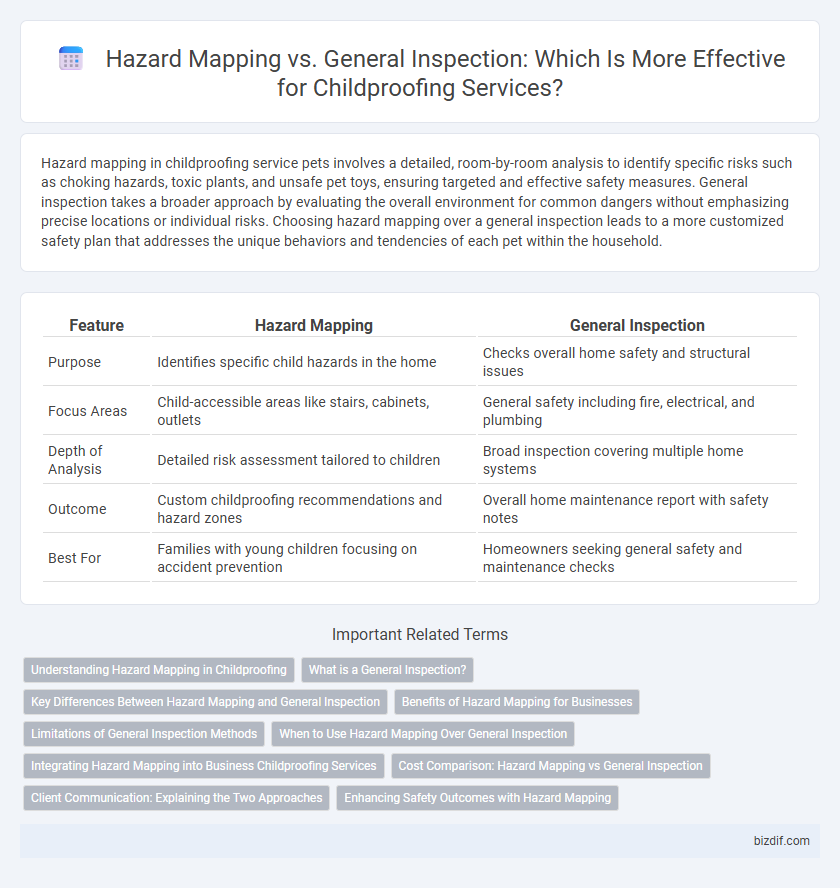Hazard mapping in childproofing service pets involves a detailed, room-by-room analysis to identify specific risks such as choking hazards, toxic plants, and unsafe pet toys, ensuring targeted and effective safety measures. General inspection takes a broader approach by evaluating the overall environment for common dangers without emphasizing precise locations or individual risks. Choosing hazard mapping over a general inspection leads to a more customized safety plan that addresses the unique behaviors and tendencies of each pet within the household.
Table of Comparison
| Feature | Hazard Mapping | General Inspection |
|---|---|---|
| Purpose | Identifies specific child hazards in the home | Checks overall home safety and structural issues |
| Focus Areas | Child-accessible areas like stairs, cabinets, outlets | General safety including fire, electrical, and plumbing |
| Depth of Analysis | Detailed risk assessment tailored to children | Broad inspection covering multiple home systems |
| Outcome | Custom childproofing recommendations and hazard zones | Overall home maintenance report with safety notes |
| Best For | Families with young children focusing on accident prevention | Homeowners seeking general safety and maintenance checks |
Understanding Hazard Mapping in Childproofing
Hazard mapping in childproofing involves identifying specific risks within a home environment through detailed spatial analysis, pinpointing areas where children are most vulnerable to accidents. Unlike general inspections that broadly assess safety features, hazard mapping uses targeted observations to map potential danger spots such as sharp edges, electrical outlets, and toxic substances. This precise method enables tailored interventions that enhance child safety by addressing the unique layout and risk factors of each household.
What is a General Inspection?
A General Inspection in childproofing evaluates the overall safety of a home by identifying common risks such as sharp edges, unsecured furniture, and accessible toxic substances. This comprehensive review covers all living areas to ensure potential hazards are detected and addressed effectively. Unlike Hazard Mapping, a General Inspection offers a broad evaluation rather than targeting specific risk zones.
Key Differences Between Hazard Mapping and General Inspection
Hazard mapping identifies specific risks within a child's environment by pinpointing exact locations and types of hazards, while general inspection offers a broader overview of overall safety conditions without intricate detailing. Hazard mapping prioritizes targeted risk analysis for childproofing strategies, whereas general inspection ensures compliance with basic safety standards. The key difference lies in hazard mapping's detailed risk localization versus general inspection's comprehensive safety assessment.
Benefits of Hazard Mapping for Businesses
Hazard mapping provides businesses with precise identification and visualization of specific risks within a child-focused environment, enabling targeted safety interventions that general inspections may overlook. This method enhances proactive risk management by highlighting high-risk areas through detailed spatial data, reducing potential liabilities and improving compliance with child safety regulations. Implementing hazard mapping leads to more efficient resource allocation for childproofing measures, ultimately fostering a safer environment for children and boosting business reputation.
Limitations of General Inspection Methods
General inspection methods often overlook specific hazards unique to child environments, resulting in incomplete safety evaluations. These inspections fail to identify hidden dangers such as unsecured cabinets, exposed electrical outlets, or toxic material locations, which are critical for effective childproofing. Relying solely on general inspections can leave families exposed to preventable accidents and injuries.
When to Use Hazard Mapping Over General Inspection
Hazard mapping is essential when detailed identification of specific risk zones in a home is required, particularly for families with infants or toddlers prone to exploring dangerous areas. Unlike general inspections, hazard mapping provides precise visual representation and prioritization of potential dangers such as sharp edges, choking hazards, and electrical outlets. Use hazard mapping over general inspections in environments with evolving child development stages where tailored safety measures must be dynamically updated.
Integrating Hazard Mapping into Business Childproofing Services
Integrating hazard mapping into business childproofing services enhances the precision of identifying and mitigating specific risks in commercial environments, surpassing the broad scope of general inspections. Hazard mapping utilizes detailed spatial analysis and risk assessment tools to pinpoint potential dangers such as sharp edges, toxic substances, and unsecured furniture, facilitating targeted prevention strategies. This approach not only improves safety outcomes but also supports compliance with regulatory standards and boosts client confidence in comprehensive childproofing solutions.
Cost Comparison: Hazard Mapping vs General Inspection
Hazard mapping typically incurs higher upfront costs than general inspection due to its detailed analysis and documentation of specific safety risks in a home environment. General inspection offers a broader, less specialized overview at a lower price but may miss nuanced hazards critical to childproofing. Investing in hazard mapping can lead to targeted safety measures, potentially reducing long-term expenses related to accident prevention.
Client Communication: Explaining the Two Approaches
Hazard mapping involves a detailed identification and visualization of specific risks within a child's environment, allowing clients to see precise danger zones and prioritize safety measures effectively. General inspection offers a broader review of the home, identifying common hazards without the in-depth spatial analysis present in hazard mapping. Clear client communication emphasizes the distinction by explaining how hazard mapping provides targeted insights for customized interventions, while general inspection ensures overall safety awareness.
Enhancing Safety Outcomes with Hazard Mapping
Hazard mapping in childproofing services involves identifying specific risk zones within a home to target safety interventions more effectively compared to general inspections that assess broader areas without detailed focus. This method enhances safety outcomes by pinpointing exact hazards such as sharp corners, electrical outlets, or toxic storage spaces, enabling tailored protective measures. Data-driven hazard mapping reduces accident rates by prioritizing high-risk locations, ensuring comprehensive child safety solutions that general inspections might overlook.
Hazard Mapping vs General Inspection Infographic

 bizdif.com
bizdif.com